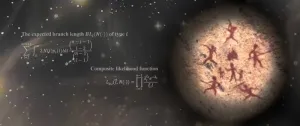(Press-News.org) Researchers from Trinity College Dublin have discovered some new and surprising ways that viral RNA and influenza virus are detected by human lung cells, which has potential implications for treating people affected by such viruses.
Influenza viruses remain a major threat to human health and can cause severe symptoms in young, elderly, and immuno-compromised populations, leading to annual epidemics which endanger between 3 and 5 million people of severe illness and cause 290,000 to 650,000 deaths worldwide.
These viruses primarily target respiratory epithelial cells to replicate, where they cause cell damage and death. Scientists have become aware that these epithelial cells are not mere passive barriers, helpless to attack, but instead are vital in driving the antiviral immune response.
However, until now, our understanding of the mechanism underpinning that response has been very limited. Now, thanks to work performed by PhD student Coralie Guy, in the research team of Andrew Bowie, Professor of Innate Immunology in Trinity’s School of Biochemistry and Immunology, some answers have arisen.
The team discovered that viral RNA and influenza viruses stimulate two different molecular pathways in which specific proteins set off chain reactions that result in two proteins called “gasdermin D” and “gasdermin E” being processed in such a way that they form membrane pores in the epithelial cells.
These pores allow the release of special agent “cytokines” charged with sparking the immune system into life, and also cause death of the cells which prevents the virus spreading.
To assess the importance of this finding, the team suppressed the formation of the gasdermin pores to see what would happen, and this resulted in increased replication of influenza viruses, underlining how important these gasdermins are in the antiviral response.
The research has just been published in the journal iScience. Speaking about the research and its implications, Professor Bowie, who is based in Trinity’s Biomedical Sciences Institute, said:
“By forming an EU-wide network of scientists with different expertise in immunology and virology, we were able to ask some fundamental questions about how our bodies respond to RNA viruses such as influenza and SARS-CoV-2.
“We realised that very little was known about the initial response to viruses in those early moments when our lungs first encounter a virus. Through Coralie’s work we were able to make some important discoveries that highlight previously unknown aspects of the immune response to influenza, which we will now build on to examine how relevant they are to other viral infections of the lung, such as SARS-CoV-2 and RSV.”
END
Scientists unpick how lung cells induce immune response to influenza
2023-08-31
ELSE PRESS RELEASES FROM THIS DATE:
Expanding the impact of CAR T cell therapy: An immunotherapy strategy against all blood cancers
2023-08-31
PHILADELPHIA – A broad new strategy could hold hope for treating virtually all blood cancers with CAR T cell therapy, which is currently approved for five subtypes of blood cancer. Scientists in the Perelman School of Medicine at the University of Pennsylvania have demonstrated the potential efficacy of this approach in preclinical tests.
In the study, published today in Science Translational Medicine, the researchers used engineered CAR T cells to target CD45—a surface marker found on nearly all blood cells, including nearly all blood cancer cells. Because CD45 is found on healthy blood cells too, the research team used CRISPR base-editing to develop a method ...
New project to make data curation accessible
2023-08-31
JooYoung Seo, assistant professor in the School of Information Sciences at the University of Illinois Urbana-Champaign, has been awarded a $649,921 Early Career Development grant from the Institute of Museum and Library Services (IMLS grant RE-254891-OLS-23), under the Laura Bush 21st Century Librarian Program, which supports “developing a diverse workforce of librarians to better meet the changing learning and information needs of the American public by enhancing the training and professional development of librarians, developing faculty and library leaders, and recruiting and ...
A step closer to digitizing the sense of smell: Monell Center, Osmo model describes odors better than human panelists
2023-08-31
PHILADELPHIA (August 31, 2023) – A main crux of neuroscience is learning how our senses translate light into sight, sound into hearing, food into taste, and texture into touch. Smell is where these sensory relationships get more complex and perplexing.
To address this question, a research team co-led by the Monell Chemical Senses Center and start-up Osmo, a Cambridge, Mass.-based company spun out of machine learning research done at Google Research, Google DeepMind (formerly known as Google Brain), are investigating how airborne chemicals connect to odor perception in the brain. To this end they discovered that a machine-learning ...
New odor map helps match perceptions of smells with their chemical structure
2023-08-31
Brian K. Lee and colleagues have developed a Principal Odor Map (POM) that models the connections between an odorant’s chemical structure with its perceptual property of smell. The map performed as well as some highly trained human “sniffers” in describing odor quality, and could be used for predicting odor intensity and perceptual similarity between odorants. The map moves researchers closer to being able to match molecular properties of odorants to their perceptual properties, a challenge that has proved difficult for olfactory science. (For other senses, neuroscientists have been able to map light wavelengths ...
Early ancestral bottleneck could’ve spelled the end for modern humans
2023-08-31
How a new method of inferring ancient population size revealed a severe bottleneck in the human population which almost wiped out the chance for humanity as we know it today.
An unexplained gap in the African/Eurasian fossil record may now be explained thanks to a team of researchers from China, Italy and the United States. Using a novel method called FitCoal (fast infinitesimal time coalescent process), the researchers were able to accurately determine demographic inferences by using modern-day human genomic sequences from 3,154 individuals. These findings indicate that early human ancestors went through a prolonged, severe bottleneck in which approximately 1,280 ...
Genomic model suggests population decline in human ancestors
2023-08-31
Between 800,000 and 900,000 years ago, the population of human ancestors crashed, according to a new genomic model by Wangjie Hu and colleagues. They suggest that there were only about 1280 breeding individuals during this transition between the early and middle Pleistocene, and that the population bottleneck lasted for about 117,000 years. The researchers say about 98.7% of the ancestral population was lost at the beginning of the bottleneck. This decline coincided with climate changes that turned glaciations into long-term events, a decrease ...
Student engagement improves calculus class outcomes among undergraduates
2023-08-31
A randomized trial involving 811 undergraduate students at a U.S. Hispanic-Serving Institution (HIS) university found that students assigned to calculus classes focused on collaborative learning and student engagement had a greater understanding of calculus concepts and improved grades compared to those assigned to classes taught in a traditional lecture style. Laird Kramer and colleagues note that the success of the engagement “treatment” occurred across all racial and ethnic groups, academic majors, and genders. Since ...
Pedigree approach estimates surprising genetic mutation rate in baleen whales
2023-08-31
A new estimate of the genetic mutation rate in four wild species of baleen whales suggests that these rates are higher than previous estimates, with some interesting implications for calculations of past whale abundance and low cancer rates. For instance, the new mutation rate determined by Marcos Suárez-Menéndez and colleagues reduces estimates of abundance in pre-exploitation whale populations by 86%, which has implications for population-rebuilding goals of whale conservation programs. The mutation rate—the probability ...
Early ancestral bottleneck could've spelled the end for modern humans
2023-08-31
This release has been removed per the request of the submitting PIO. END ...
Developing silicones that are friendlier toward health and the environment
2023-08-31
Polysiloxanes, the scientific name for silicones, possess exceptional properties, and are used in numerous fields ranging from cosmetics to aerospace. They are absolutely everywhere! However, they have a major flaw, as small, cyclic oligosolixanes—toxic for the environment and identified as an endocrine disruptor—form during their synthesis. To correct this drawback, a team of scientists1 led by a CNRS researcher recently developed a new process for synthesising silicones in a cleaner and more environmentally-friendly ...

